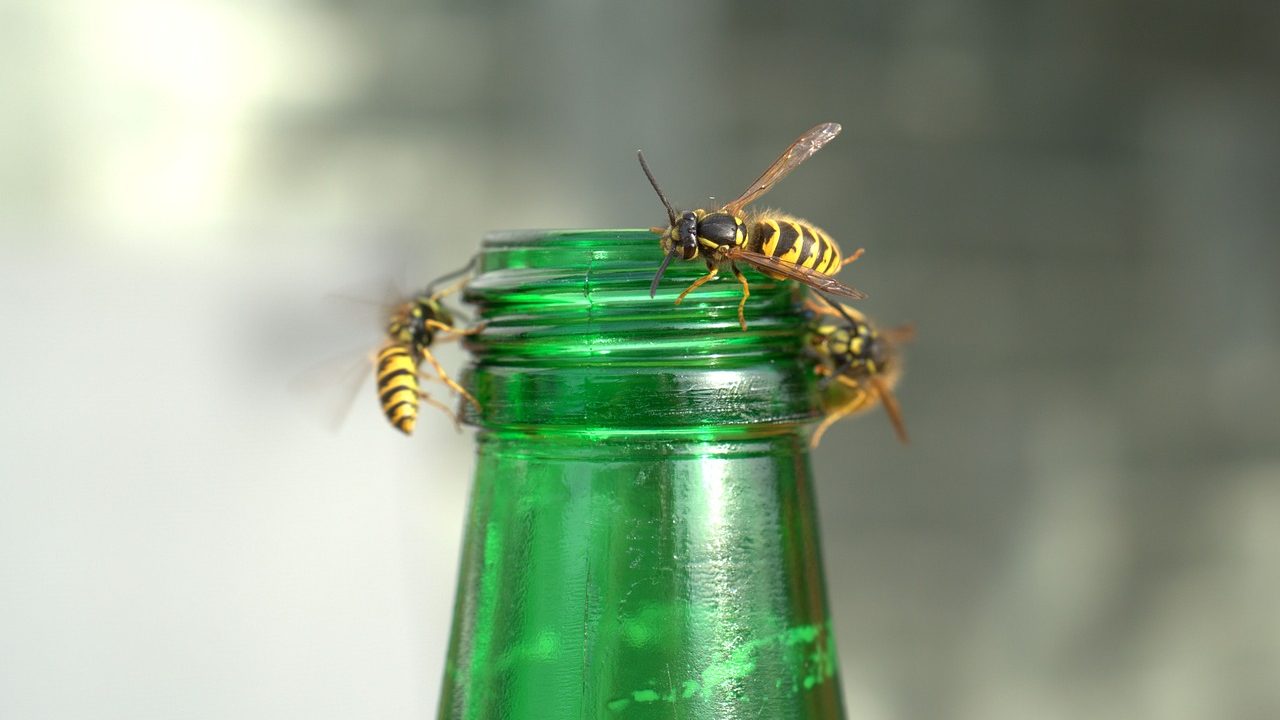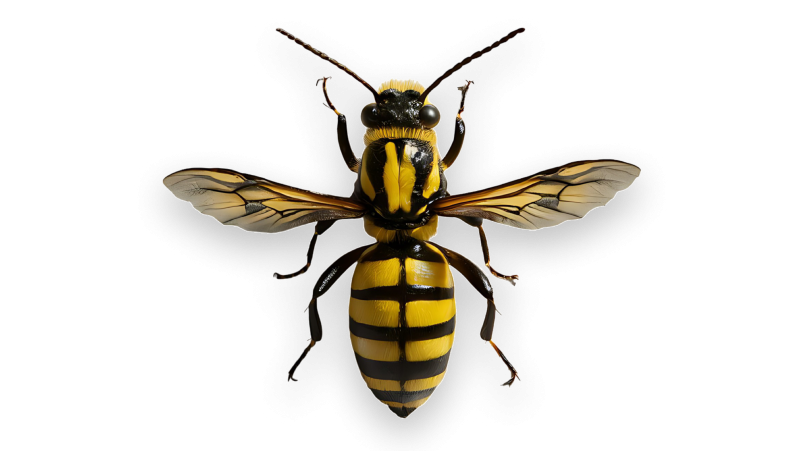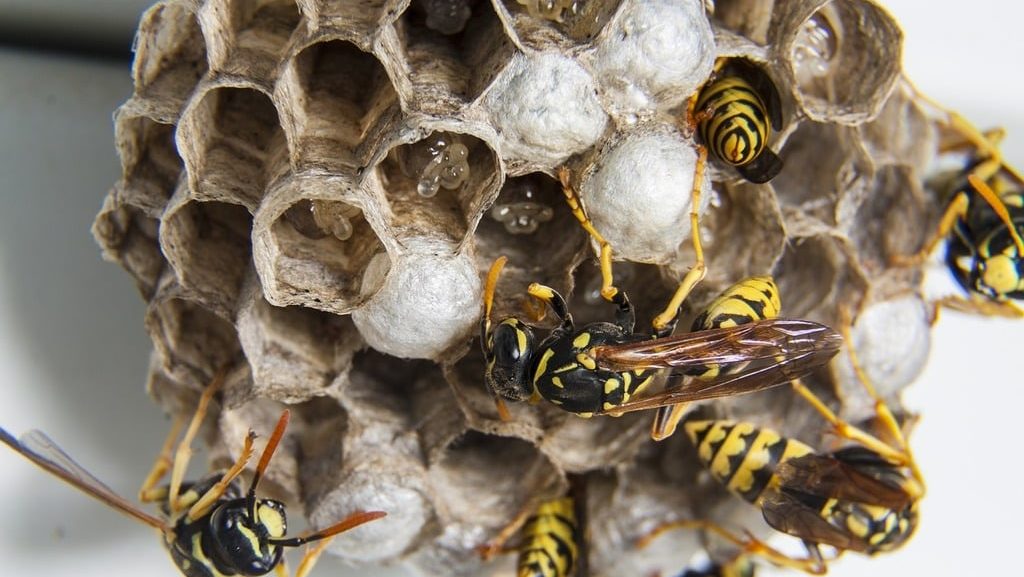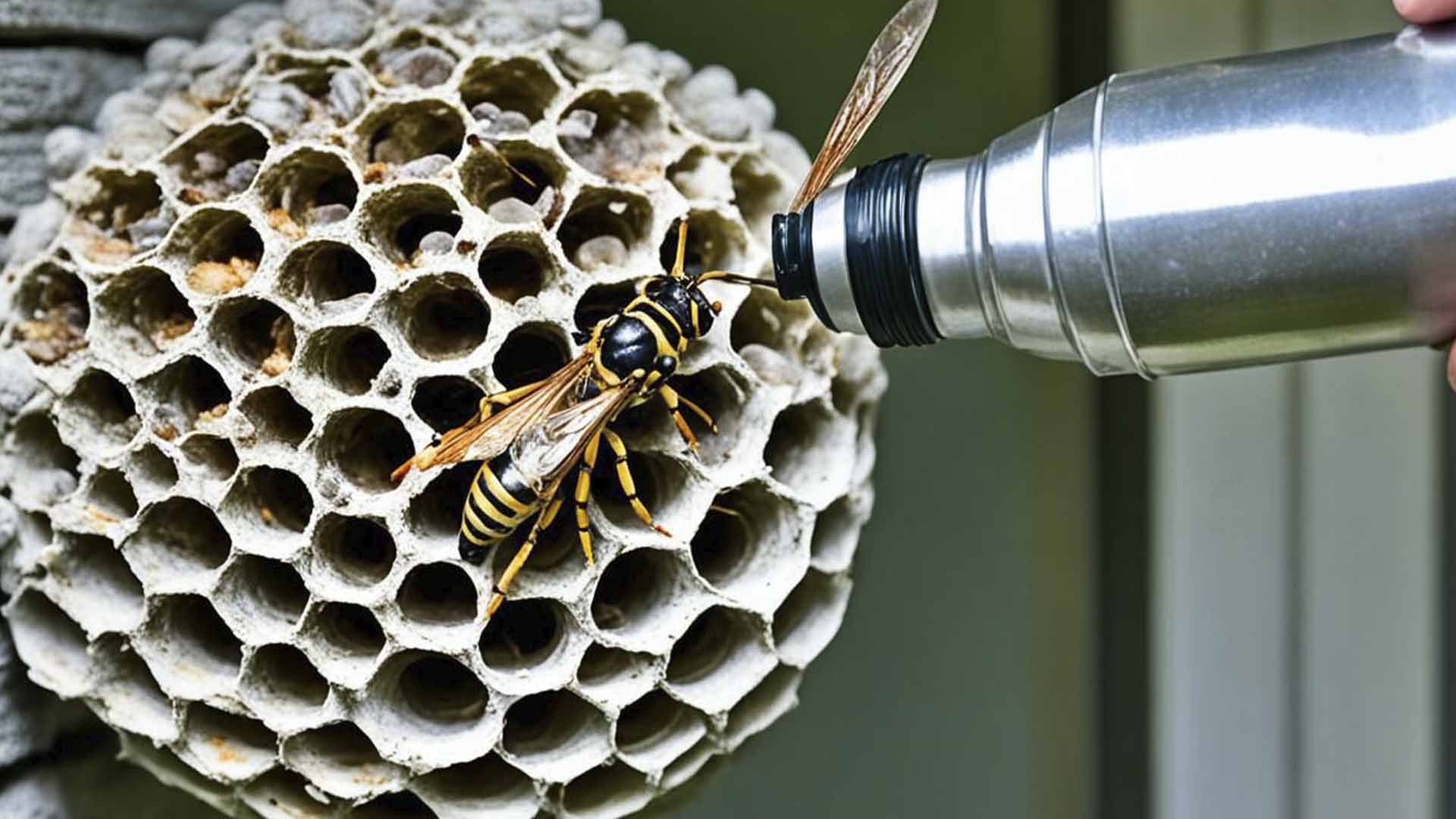Key Takeaways
- Stay calm and avoid sudden movements if you see a wasp indoors.
- Create an exit path by opening windows or doors and dimming indoor lights.
- Capture and release the wasp using a jar and stiff paper.
- Use natural deterrents like peppermint oil to guide the wasp out.
- Seal entry points and use natural repellents to prevent future infestations.
 Wasps are flying insects known for their slender bodies, narrow waists, and distinctive yellow-and-black or brownish coloration. Unlike bees, wasps have smoother, less hairy bodies and are generally more aggressive, capable of stinging multiple times. They play beneficial ecological roles by controlling pest populations, as they feed on insects and spiders.
However, wasps can become a nuisance around homes and gardens, especially when attracted by sugary foods, garbage, or when nesting near human dwellings. Their presence often requires careful management to prevent potential stings or allergic reactions.
Wasps are flying insects known for their slender bodies, narrow waists, and distinctive yellow-and-black or brownish coloration. Unlike bees, wasps have smoother, less hairy bodies and are generally more aggressive, capable of stinging multiple times. They play beneficial ecological roles by controlling pest populations, as they feed on insects and spiders.
However, wasps can become a nuisance around homes and gardens, especially when attracted by sugary foods, garbage, or when nesting near human dwellings. Their presence often requires careful management to prevent potential stings or allergic reactions.
How to Safely Get a Wasp Out of Your House
Discovering a wasp buzzing inside your home can be unsettling. These insects are not only intimidating but can pose a risk of painful stings, especially if provoked. Acting quickly and using safe methods to remove the wasp is essential to protect yourself and your family.

Not getting a solution?
Get your free pest control estimate today!What to Do if a Wasp Is in Your House?
Spotting a wasp indoors can be nerve-wracking, but remaining calm is the key to handling the situation effectively. Wasps are typically not aggressive unless they are disturbed, so it’s important to approach the problem with caution. Follow these steps:Steps to Handle a Wasp Indoors: Safe and Effective Methods
Encountering a wasp indoors can cause panic and confusion—but knowing exactly how to respond can prevent unnecessary stings and reduce stress. Follow these detailed, step-by-step guidelines to safely and effectively handle a wasp inside your home. 1. Stay Calm and Avoid Sudden Movements When you notice a wasp indoors, the first and most crucial step is to remain calm. Wasps respond aggressively to sudden movements, loud noises, or rapid gestures.Why This Works
-
Avoids Provoking Aggression: Sudden movements can signal threat to wasps, triggering defensive stings.
-
Maintains Safety: Staying calm helps prevent escalation and reduces the risk of getting stung.
How to Implement
-
Remain Still: Freeze briefly when a wasp is near and stay calm to avoid alarming it.
-
Move Slowly: Carefully and slowly distance yourself without swatting or flailing.
-
Avoid Loud Noises: Keep voices low and avoid sudden sounds to maintain a peaceful environment.
Why This Works
-
Easier Management: Limiting the wasp to one area makes it easier to guide or remove safely.
-
Reduces Panic and Risk: Containing the wasp minimizes stress and reduces the chance of accidental stings.
How to Implement
-
Identify the Room: Close doors to keep the wasp from entering other parts of your home.
-
Clear the Area: Remove pets and children to maintain calm and avoid provoking the wasp.
-
Prevent Further Entry: Close windows and interior doors to contain the wasp in a controlled space.
Why This Works
-
Natural Attraction to Light: Wasps are drawn to sunlight, making bright exits more appealing for escape.
-
Reduces Indoor Risk: Guiding the wasp out using light minimizes the need for direct interaction and reduces sting risk.
How to Implement
-
Turn Off Lights: Switch off indoor lighting to make the outdoor exit more noticeable to the wasp.
-
Open a Single Exit: Create a clear exit by opening one window or door near the wasp’s location.
-
Reduce Distractions: Close blinds or curtains on other windows to focus the wasp’s attention on the open path.
Why This Works
-
Non-Threatening Guidance: Slow, calm movements help avoid triggering defensive behavior, making removal safer and more effective.
-
Safe Removal: Gentle guiding minimizes the risk of stings compared to aggressive tactics like swatting or spraying.
How to Implement
-
Use a Safe Tool: Use a magazine, newspaper, or cardboard as a non-threatening guide to direct the wasp.
-
Slowly Guide: Stand to the side or behind the wasp and use gentle, sweeping motions toward the open exit.
-
Maintain Patience: Stay calm and allow time if the wasp doesn’t respond immediately—rushing increases risk.

How to Safely Catch a Wasp in the House?
If the wasp doesn’t leave on its own, capturing and releasing it safely is a humane option. To do this:Steps to Safely Catch and Release a Wasp
-
Gather Tools: Use a clear jar or glass and a stiff piece of paper or cardboard.
-
Capture the Wasp: Wait for it to land, then place the jar over it and slide the paper under to trap it.
-
Release Outdoors: Slowly carry the jar outside and release the wasp from a safe distance.
Alternative Methods for Removing a Wasp
If capturing the wasp isn’t feasible, consider these alternative techniques:Methods
-
Open Windows and Doors: Turn off indoor lights and provide an escape route to encourage the wasp to exit.
-
Natural Deterrent Spray: Mix water, dish soap, and peppermint oil to create a spray that slows the wasp down and guides it out.
-
DIY Trap: Use sugar water or soda in a dish to attract the wasp near an exit.
-
Use a Fan: Direct airflow towards an open window or door to push the wasp outside gently.

How to Prevent Wasps From Entering Your House?
Keeping wasps out is the most effective way to avoid dealing with them indoors. Follow these preventive measures:Tips to Prevent Wasps Indoors: Effective Strategies for a Wasp-Free Home
Wasps entering your home can quickly become more than just a nuisance—they pose risks through painful stings and potential allergic reactions. By proactively employing these detailed preventive measures, you can significantly reduce the chances of wasps invading your indoor spaces. 1. Seal Cracks and Gaps Around Doors and Windows
Wasps commonly gain access to homes through tiny cracks and gaps around doors, windows, and foundations. Properly sealing these entry points is a crucial first step in preventing indoor infestations.
1. Seal Cracks and Gaps Around Doors and Windows
Wasps commonly gain access to homes through tiny cracks and gaps around doors, windows, and foundations. Properly sealing these entry points is a crucial first step in preventing indoor infestations.
Why This Works
-
Physical Barrier: Sealing even small cracks prevents wasps from entering, creating an effective physical block.
-
Long-term Protection: Unlike short-term solutions, sealing entry points offers consistent, year-round defense against wasps and other pests.
How to Implement
-
Inspect Your Home: Check around windows, doors, foundations, vents, and utility entries for gaps or cracks.
-
Use Quality Caulk or Sealant: Seal small gaps with silicone or latex caulk; use expanding foam or weatherproof tape for larger openings.
-
Check Frequently: Inspect regularly, especially after seasons or storms, to maintain effective sealing and prevent new entries.
Why This Works
-
Physical Barrier: Sealing even small cracks prevents wasps from entering, creating an effective physical block.
-
Long-term Protection: Unlike short-term solutions, sealing entry points offers consistent, year-round defense against wasps and other pests.
How to Implement
-
Inspect Your Home: Check around windows, doors, foundations, vents, and utility entries for gaps or cracks.
-
Use Quality Caulk or Sealant: Seal small gaps with silicone or latex caulk; use expanding foam or weatherproof tape for larger openings.
-
Check Frequently: Inspect regularly, especially after seasons or storms, to maintain effective sealing and prevent new entries.
 3. Eliminate Sugary Food and Beverage Attractants
Wasps are strongly attracted to sugary foods and beverages, making your home particularly vulnerable if food sources are readily accessible. Removing these attractants significantly decreases the chances of wasps invading your indoor spaces.
3. Eliminate Sugary Food and Beverage Attractants
Wasps are strongly attracted to sugary foods and beverages, making your home particularly vulnerable if food sources are readily accessible. Removing these attractants significantly decreases the chances of wasps invading your indoor spaces.
Why This Works
-
Reduces Attractiveness: Eliminating sweet food and drink residues makes your home less appealing to wasps.
-
Discourages Nesting: A lack of accessible food sources makes it less likely for wasps to nest nearby.
How to Implement
-
Secure Food Storage: Keep sweet foods and drinks in airtight containers or refrigerated to keep them out of wasp reach.
-
Prompt Cleanup: Clean spills of juice, soda, or syrup immediately, especially in food prep areas.
-
Waste Management: Empty trash bins often and use sealed lids to prevent wasp-attracting odors.
Why This Works
-
Natural Deterrent: Scented plants like mint and citronella repel wasps and other insects with their strong aromas.
-
Safe and Eco-Friendly: These natural options are non-toxic and safe for families, pets, and the environment.
How to Implement
-
Strategic Placement: Place mint, citronella, basil, lemongrass, and lavender near doors, windows, and patios to create scent barriers.
-
Regular Care: Water, prune, and repot your plants consistently to keep them healthy and effective.
-
Additional Methods: Crush or bruise plant leaves occasionally to release essential oils and boost repellent power.

Myths and Facts About Getting a Wasp Out of Your House
| Myth | Fact |
|---|---|
| Wasps will not sting indoors. | Wasps can sting indoors if they feel threatened. |
| Turning off all lights will drive wasps out. | Using a single light source to guide them is more effective. |
| All wasps indoors are aggressive. | Many wasps indoors are not aggressive and are trying to escape. |
| Wasps indoors build nests immediately. | Wasps are unlikely to start building a nest right away indoors. |
| Killing wasps indoors is the best solution. | Guiding them outside is safer and more humane. |
Why Choose Our Wasp Control Services?
With expertise in handling different species and effective Wasp control methods, we ensure your home remains wasp-free. Our professionals understand the best ways to target wasp infestations and other pest problems, providing long-lasting relief without compromising safety.Need an estimate for pest control? Our team is standing by, ready to help. Get A Risk-Free Estimate.





